Triamcinolone
 | |
 | |
| Clinical data | |
|---|---|
| Trade names | Kenalog, Nasacort, & more. (See Brand names) |
| Other names | Click show to see
(8S,9R,10S,11S,13S,14S,16R,17S)-9-fluoro-11,16,17-trihydroxy-17-(2-hydroxyacetyl)-10,13-dimethyl-6,7,8,9,10,11,12,13,14,15,16,17-dodecahydro-3H-cyclopenta[a]phenanthren-3-one; (1R,2S,10S,11S,13R,14S,15S,17S)-1-fluoro-13,14,17-trihydroxy-14-(2-hydroxyacetyl)-2,15-dimethyltetracyclo[8.7.0.02,7.011,15]heptadeca-3,6-dien-5-one |
| AHFS/Drugs.com | Monograph |
| Pregnancy category |
|
| Routes of administration | Oral, topical, IM, intra-articular, intrasynovial |
| ATC code | |
| Legal status | |
| Legal status | |
| Pharmacokinetic data | |
| Protein binding | 68% |
| Metabolism | Hepatic |
| Elimination half-life | 88 minutes |
| Excretion | Fecal and renal |
| Identifiers | |
| |
| CAS Number | |
| PubChem CID | |
| IUPHAR/BPS | |
| DrugBank | |
| ChemSpider | |
| UNII | |
| KEGG | |
| ChEBI | |
| ChEMBL | |
| CompTox Dashboard (EPA) | |
| ECHA InfoCard | 100.004.290 |
| Chemical and physical data | |
| Formula | C21H27FO6 |
| Molar mass | 394.434 g/mol g·mol−1 |
| 3D model (JSmol) | |
| |
| |
| | |
Triamcinolone is an intermediate-acting synthetic glucocorticoid given orally, by muscular, Intra-articular, intrasynovial, intrabursal, soft-tissue, intralesional, or sublesional injection, by inhalation, or as a topical ointment or cream.[1]
Uses
Triamcinolone is used to treat a number of different medical conditions, such as eczema, lichen sclerosus, psoriasis, arthritis, allergies, ulcerative colitis, lupus, sympathetic ophthalmia, temporal arteritis, uveitis, ocular inflammation, keloids, urushiol-induced contact dermatitis, aphthous ulcers (usually as triamcinolone acetonide), visualization during vitrectomy and the prevention of asthma attacks. It will not treat an asthma attack once it has already begun.[2][3][4][failed verification]
The derivative triamcinolone acetonide is the active ingredient in various topical skin preparations (cream, lotion, ointment, aerosol spray) designed to treat dermatological conditions such as rash, inflammation, redness, or intense itching due to eczema[5] and dermatitis.[6]
Side effects
Side effects of triamcinolone include sore throat, nosebleeds, increased coughing, headache, and runny nose.[citation needed] White patches in the throat or nose indicate a serious side effect.[clarification needed] Symptoms of an allergic reaction include rash, itch, swelling, severe dizziness, trouble breathing.[7]
Chemistry
Triamcinolone is a synthetic pregnane corticosteroid and derivative of cortisol (hydrocortisone) and is also known as 1-dehydro-9α-fluoro-16α-hydroxyhydrocortisone or 9α-fluoro-16α-hydroxyprednisolone as well as 9α-fluoro-11β,16α,17α,21-tetrahydroxypregna-1,4-diene-3,20-dione.[8][9]
Society and culture
In 2010, TEVA and Perrigo launched the first generic inhalable triamcinolone.[10]
According to Chang et al (2014), "Triamcinolone acetonide (TA) is classified as an S9 glucocorticoid in the 2014 Prohibited List published by the World Anti-Doping Agency, which caused it to be prohibited in international athletic competition when administered orally, intravenously, intramuscularly or rectally".[11]
Brand names
Trade names for triamcinolone include Aristocort (Sandoz, now Novartis), Kenacort (Bristol-Myers Squibb), Kenalog (Bristol-Myers Squibb), Tricort (Cadila), Triaderm (Schering-Plough), Azmacort (KOS), Trilone, Volon A, Tristoject, Tricortone, Ratio-Triacomb, and Trianex.
See also
- Glucocorticoid (a chart comparing various glucocorticoids)
- Triamcinolone acetonide
References


- ^ Chrousos G, Pavlaki AN, Magiakou MA (2011). "Glucocorticoid Therapy and Adrenal Suppression". PMID 25905379.
{{cite journal}}: Cite journal requires|journal=(help) - ^ Triamcinolone - Drugs.com
- ^ Triamcinolone Inhalation - Drugs.com
- ^ Alcon Receives FDA Approval of Triesence Injectable Triamcinolone Suspension for Use in Eye Surgery - Drugs.com
- ^ Chong, Melanie; Fonacier, Luz (2015). "Treatment of Eczema: Corticosteroids and Beyond". Clinical Reviews in Allergy & Immunology. 51 (3): 249–262. doi:10.1007/s12016-015-8486-7. ISSN 1080-0549. PMID 25869743.
- ^ Eichenfield, Lawrence F.; Tom, Wynnis L.; Berger, Timothy G.; Krol, Alfons; Paller, Amy S.; Schwarzenberger, Kathryn; Bergman, James N.; Chamlin, Sarah L.; Cohen, David E. (2014). "Guidelines of care for the management of atopic dermatitis". Journal of the American Academy of Dermatology. 71 (1): 116–132. doi:10.1016/j.jaad.2014.03.023. ISSN 0190-9622. PMC 4326095. PMID 24813302.
Topical corticosteroids (TCS) are used in the management of AD in both adults and children and are the mainstay of anti-inflammatory therapy.
- ^ "Drugs and Treatments - Nasacort AQ Nasl - Patient Handout". WebMD. Retrieved 2008-03-24.
- ^ J. Elks (14 November 2014). The Dictionary of Drugs: Chemical Data: Chemical Data, Structures and Bibliographies. Springer. pp. 1228–. ISBN 978-1-4757-2085-3.
- ^ Index Nominum 2000: International Drug Directory. Taylor & Francis. January 2000. pp. 1054–. ISBN 978-3-88763-075-1.
- ^ Perrigo Announces Launch Of Generic Version Of Nasacort AQ - CBS Detroit
- ^ Chang, Chih-Wei; Huang, Tai-Yuan; Tseng, Yi-Chun; Chang-Chien, Guo-Ping; Lin, Su-Fan; Hsu, Mei-Chich (2014). "Positive doping results caused by the single-dose local injection of triamcinolone acetonide". Forensic Science International. 244: 1–6. doi:10.1016/j.forsciint.2014.07.024. PMID 25126738.
{{cite journal}}: Cite has empty unknown parameter:|1=(help)
